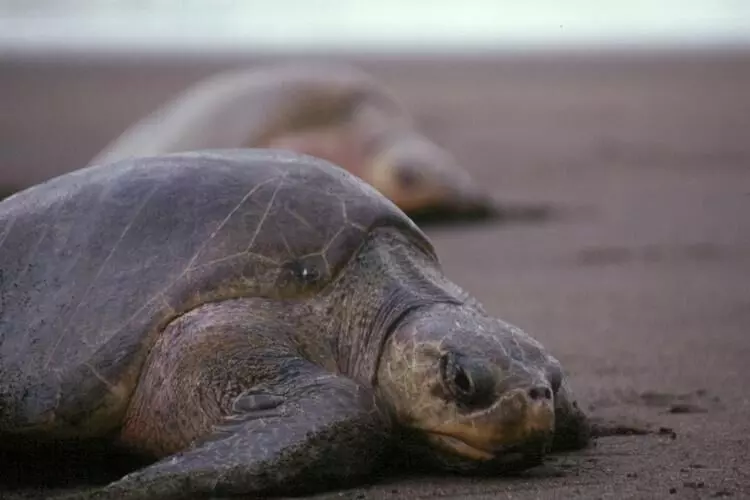What caused the death of over 2,641 olive ridley turtles along the Andhra coast
To tackle this issue, the TREE Foundation has proposed a multi-pronged approach
By Sri Lakshmi Muttevi
Visakhapatnam: Over 2,641 olive ridley turtles were found dead along the Andhra Pradesh coast in January alone, the TREE Foundation said.
TREE Foundation, an India-based NGO focusing on marine conservation, said if urgent action is not taken to curb bycatch and illegal fishing, this vulnerable species will remain at significant risk, affecting their nesting period.
Andhra Pradesh coastline is one of the major nesting spaces for olive ridley turtles. These are listed as vulnerable by the International Union for the Conservation of Nature (IUCN). Beaches in the Andhra Pradesh coastal region, especially Visakhapatnam, are frequented by olive ridley turtles during nesting season.
However, the death of vulnerable species is raising serious concern about conservation efforts in this region.
What is nesting, and when is it?
Olive ridley turtles nest every year, sometimes multiple times per season. Beaches near Sullurpeta, Tirupati, Nellore, Prakasam, Bapatla, the Krishna and Godavari estuaries, Kakinada, Anakapalli, Visakhapatnam, Vizianagaram, and Srikakulam serve as crucial nesting grounds. Offshore waters in these regions are also vital migration corridors.
The nesting period of the Turtles is generally from November to March, with the peak being from January to February. They lay clutches of about 100 eggs and use their whole bodies to beat the sand down on top of their eggs.
Eggs take about 45–65 days to hatch. To conserve the eggs during the incubation period, the Forest Department sets up hatcheries along the coastline. Each hatchery stations 3-4 fishermen who scour as much as 6-7 km daily for the turtle eggs. The eggs are brought back to the safe spot- the hatchery, which is also guarded by the fishermen to ensure no one enters the nesting area. The hatcheries are rectangular-shaped areas covered by tall makeshift sticks that ensure no one enters the area.
Olive Ridley Turtles have a connection with the shore they are born in. When these hatchlings come of age, they come back to the same location to lay the eggs. After they hatch, hundreds of baby turtles dig their way out. Once the babies are out, the department releases all of them in batches.
Nesting Numbers dropped:
According to the TREE Foundation, the nesting number of the Olive Ridley Turtle in 1979 was 100 nests per kilometer each year. Today, only 10-11 turtle nests per kilometer are to be found.
What is the biggest threat?
Olive Ridley turtles, while migrating for breeding, are often trapped in fishing nets, including trawl nets and gillnets. Now, with the growing intensity of mechanized fishing, especially by Tamil Nadu and AP-registered vessels operating near the coast during the nesting season, the death of turtles has increased.
"However, the intensification of mechanized fishing activities, particularly the use of trawl nets and gillnets, has led to accidental entanglements and drowning of turtles. The situation has worsened due to increased fishing pressure from both Tamil Nadu and Andhra Pradesh-registered vessels operating near the coast during the nesting season," said Dr Supraja Dharini, Chairperson of TREE Foundation.
She urged that the increasing number of turtle deaths along the AP coast points to the urgent need for stricter enforcement of existing MFRA regulations.
"The most significant threat is bycatch mortality, where turtles are inadvertently captured in fishing nets. Turtles need to surface for air every 40 to 45 minutes. When trapped in fishing nets, they drown due to prolonged entanglement," she added.
Dr. Dharini emphasized that the current level of bycatch mortality due to illegal fishing activities significantly impacts the olive ridley population, which already faces numerous challenges. She emphasized that joint conservation efforts on nesting beaches have been successful, largely due to the support and involvement of the AP Forest Department.
She also highlighted the active participation of 283 fishermen and tribal members in community-based sea turtle conservation initiatives.
To address this issue, the TREE Foundation has proposed a multi-pronged strategy, including strict enforcement of existing regulations and awareness campaigns among fishing communities. These include increased patrolling by dedicated boat teams, more stringent enforcement of fishing regulations, and the implementation of awareness campaigns within fishing communities.
Dr Dharini called for stricter penalties for violations of the AP Marine Fisheries Regulation Act (APMFRA), particularly regarding illegal fishing within 8 km of the shore.
“The need for substantial penalties to deter violations is critical. The current fines and penalties do not adequately reflect the seriousness of the situation,” she felt.
Measures:
To tackle this issue, the TREE Foundation has proposed a multi-pronged approach:
1. Strict Enforcement of Existing Regulations: Increasing patrolling by dedicated boat teams and implementing stringent fishing regulations, particularly within 8 km of the shore.
2. Stronger Penalties: Enforcing substantial penalties for violations of the Andhra Pradesh Marine Fisheries Regulation Act (APMFRA) to deter illegal fishing activities.
3. Mandatory Vessel Monitoring Systems (VMS): Implementing VMS for all fishing boats to track and monitor their movements.
4. Ban on Harmful Fishing Gear: Prohibiting the use of ray fish nets, squid nets, and nanajaathi nets during the breeding season.
5. Awareness Campaigns: Conducting intensive education programs for fishing communities on the importance of turtle conservation.